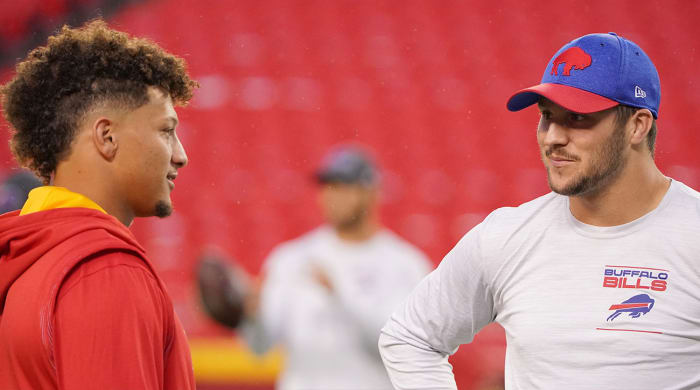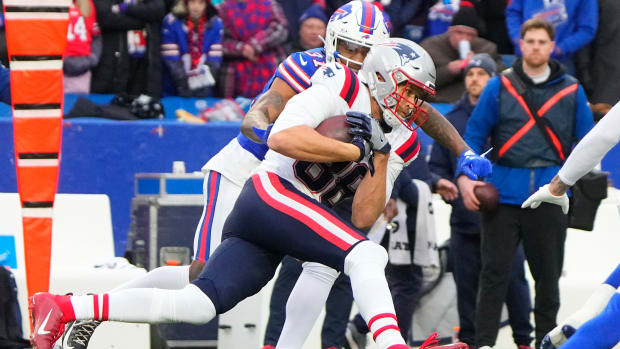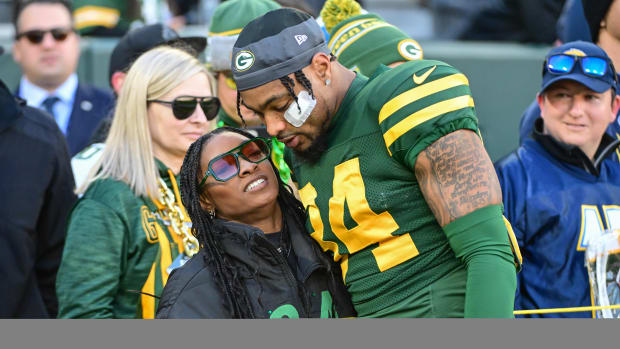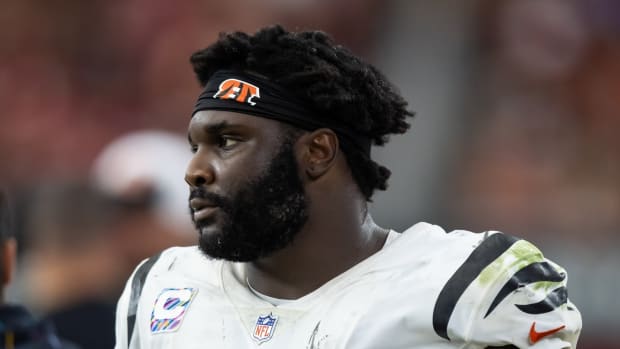GamePlan: How the 17-Game Season Looks After a Week of the Playoffs
The easy thing to do would be to look at the Buccaneers and sneer at the new playoff format and 17-game gantlet every player just had to endure. And to be sure, it’s definitely worth approaching this topic, in general, given the NFL’s track record, with skepticism.
But as I dived into the impact of all the extra games being played the last two years, and whether it’s good for football, much less football players, one team doctor cautioned me not to make leaps based on what we all watched in Tampa last Sunday. Because, really, no amount of rest was going to prevent either of the big injuries the Bucs sustained.
All-Pro right tackle Tristan Wirfs was first to go down, hurt on the fourth play of Sunday’s game against the Eagles. He got caught underneath Javon Hargrave, who rolled up on Wirfs while diving to bring down Bucs tailback Ke’Shawn Vaughn. And by the end of the first quarter, Bucs center Ryan Jensen was injured, too, his injury coming on the goal line, when Eagles defensive lineman Milton Williams knocked Tampa Bay left tackle Donovan Smith into the back of his leg, sending Jensen backward to the ground with a turned ankle.
And the doc was right—those injuries, both by contact, were what they were, each being among those football equivalents of a car accident, where into the number of big dudes running into one another on a given play results in one of those dudes going down. These kinds, of course, can happen in Week 2, the same way they might in the playoffs.
So, no, this wasn’t a case of the wear and tear of a longer season exacting a price from a couple of NFL players. But in their own way, the injuries did underscore the complexities involved in playing more games.
One, there’s the competitive aspect of it. The Buccaneers, until two years ago, would’ve gotten a bye, by virtue of holding the NFC’s second seed—something that could’ve been a difference-maker for a roster stocked with older veterans. Instead, they were playing in the wild-card round, which naturally exposed their guys young (Wirfs) and old (Jensen) to another week of risk.
Two, there’s the fact that the law of averages catches up to most players, with the number of games they play. So in this case, you can look at a younger player like Wirfs, and see that the path to a life-changing second contract will now require an extra game every year, meaning this year’s rookies need to make it through 68 regular-season games to be eligible for free agency rather that 64. And for an older guy like Jensen, every game played might be one less chance you make it to that final year or two of your prime earning power.
Was expanding the regular season to 17 games the right call? Was expanding the playoffs smart?
It depends on whom you ask.
For the guys writing the checks, it was. For those cashing them, it’s more complicated.
The best weekend of the NFL season is on tap, and the GamePlan is here to get you ready for it. Inside this week’s column, you’ll find …
• A look at the top story lines to follow in the divisional games.
• Some coaching carousel themes to follow.
• Flawless (so far) playoff gambling advice!
But we’re starting with where we are in the NFL, after the longest regular season ever.
Laken Tomlinson is in his seventh NFL season and, through all that experience, he’s learned to buy into the one-week-at-a-time cliché that football coaches have peddled for decades. It focuses the Niners’ guard in how he gets ready for each opponent. It also informs how he gets his 6' 3", 315-pound body in position to lock horns every week.
“If you look at it as a whole, 17 games versus 16 games, I can see where some people might say adding that extra game is a lot, if you’re looking at all of it in totality,” said the 29-year-old. “But when it comes to managing it, especially the guys up front, we look at it as a one-game-at-a-time mentality. It’s just the next game. And when you go about it that way through the season, you really don’t care how many games you play.
“Because it’s just the next game.”
Which has meant, for Tomlinson, being as strict as he can be with a routine that’s built to ramp him up every week. Through the offseason, and into the season, he’s focused much of his preparation on “prehab” recovery work, aimed at preventing injuries—and that’s meant two massages per week, two trips to the chiropractor per week, dry needling and a weekly appointment with a personal trainer, on top of regular football and strength work.
“I knew it was gonna be a longer year. I was just a little more diligent with my prehab in the offseason,” Tomlinson said. “I really made sure my body was in tip-top form, not only for the grind in training camp but throughout the season as well. I did a lot more prehab stuff, fine-tuning the body and preparing myself for the grind.”
Tomlinson then said he took from the 19-game Super Bowl season of two years ago, and the Niners did, too. Among other things, the teams’ trainers advised for players to be on top of their sleep—and coaches have driven home the message, Tomlinson said, by doing things like scaling back, say, 30 minutes or so in a meeting on a given day and instructing the players to allot the time go get rest.
And the Niners have hardly been the only team to be mindful of how a 17th game might affect the roster.
The Rams were more aggressive this year about pulling starters in blowout wins over the Giants, Texans and Jaguars, to try to save a few miles on those guys’ legs. The Panthers worked to overstock positions that they knew would be hard to backfill—they were able to pull it off at corner, but couldn’t on the offensive line—if the injury rate caught up to them later in the year. And the Cardinals added extra “veteran days” to the schedule, where the older guys on the roster would be able to get practices off.
The Eagles did a lot of that work, too, while applying Tomlinson’s principle to it.
Three years ago, Philly overhauled its medical staff and hired Dr. Arsh Dhanota, who’d worked in other pro sports, of the University of Pennsylvania to run point as chief medical officer. The team ranked dead-last in most injury metrics in the NFL (such as man games lost), and wanted to try to flip that to create an advantage medically.
From there, came a three-year plan to streamline communication between athletic training, strength and conditioning, nutrition and sport science within the building, and blend a mountain of medical data from those areas with subjective feedback from the coaches and players. The hope was the Eagles would be in the top 15 in the aforementioned metrics by 2022. They were comfortably in that range already this year.
Some of that is always luck. But the Eagles wanted to control what they could by identifying what data was important (a player’s overall physical load, for example) and integrating that into how a player would need to ramp up every week (they’d make sure he maxed out at some point during the week, to prepare his body for the game), then de-load after the game.
From there, they’d monitor each player week to week to stay on top of changes, and it worked to the point where Philly’s data showed players’ hitting max speeds more often during the second half of the season than they did in the first, because they were adapting to the grind without burning out. Another key? This system was bespoke, with each player having a different plan.
There were tests along the way that forced the Eagles to adapt (a COVID-19 outbreak in Washington pushed a Sunday game to Tuesday, creating a pair of affected game weeks), and they learned along the way. And when it was over, they were healthy going into the playoffs, and got there riding a four-game winning streak before, yes, giving a bunch of guys rest in the team’s Week 18 regular-season finale against the Cowboys.
Maybe that didn’t help much against Tampa Bay last weekend. Then again, the quarterback Philadelphia was facing is pretty aware of all this stuff, too.
The NFLPA has been watching this closely—but there’s an admission there that everyone’s probably still years away from having a true gauge on how the extra week and expanded playoffs are affecting the league’s player population.
What the union does know already is just how divisive the issue of 17 games remains.
One union official estimated to me that players are split 50-50 on it, and that 2020’s razor-thin margin to approve the new CBA reflects the divide on this specific topic.
“For the players who believed we got enough, they’re happy because they got more for playing the extra game,” he said. “Those who didn’t, they begrudgingly accepted the reality of it. … That sentiment remains.”
Players in general, he continued, are probably more ticked off about having to play on Thursdays than having to play the extra game, because the extra game check has, indeed, worked to soften the blow. And the expanded playoffs, really, don’t make as much of a difference in that regard, since it’s just two more teams having to go through four games, rather than three, to win a championship. No one’s suddenly having to play five playoff games.
Still, there are players who maintain the new format, as one union rep said, is “just not good for guys.” And there’s merit to that thought, too.
One more game is one more opportunity for a player to get hurt in the way Wirfs or Jensen did—and that’s without considering the chance certain guys might (despite all the work teams like the Eagles are doing) wear down over the course of a longer year, and end up more susceptible to injury on the back end.
Then, there’s the business aspect of it we mentioned earlier, and how a player has to get through 68 regular-season games now, instead of 64, to make it to unrestricted free agency. And all of it’s worth taking into account.
To offset it, the union’s negotiated for more rest during other parts of the calendar—in the spring, training camp and even through teams’ in-season practice schedule—and anecdotal evidence has come back from players that guys have come out of the grind of the season feeling healthier and fresher as a result. Additionally, four of the eight teams still alive (Bucs, Rams, Packers, Bengals) had players negotiate a huge reduction in team-led offseason work, and a fifth (Titans) had modified tempo for its offseason program.
That only underscores, of course, how everyone is still trying to figure out the right way to handle this new world.
Tomlinson, for his part, is too, which is why he keeps going back to how he felt through, and ultimately handled, the Niners’ run to February two years ago. There are a ton of little things he’s repeating. But the big thing remains the same—which is staying on top of everything.
“I just remember that feeling, obviously it was a long, grueling year, and you get nicks and bruises throughout the season,” he said. “I just had the experience, just a sort of check with myself, see where my body is at type thing, and anything that pops up I have the knowledge to fix it before the game. It’s a lot of stuff we did back in 2019 that I’m still doing today. It’s helped me a lot having that experience under my belt.”
It’s still football, of course, so what happened to Wirfs and Jensen could happen to him—and now there are more opportunities for it to, for sure.
But as he sees it, this is what he signed up for, and so he’ll figure it out as he goes. It’s gotten him this far, and given him a lot to look forward to this weekend. And the Bucs can only hope that Wirfs and Jensen have plenty to be excited about over the next few days, too.

Patrick Mahomes vs. Josh Allen headlines the divisional round schedule.
Denny Medley/USA TODAY Sports
FIVE STAR MATCHUPS
1) Bills at Chiefs (Sunday, 6:30 p.m. ET): This, to me, is the crown jewel of the NFL weekend—26-year-old Patrick Mahomes vs. 25-year-old Josh Allen. It’ll be Mahomes’s 10th playoff start (he’s 7–2) and Allen’s sixth (he’s 3–2), remarkably high numbers for guys so young. And obviously, both guys have the talent to match, and it feels like this is the sort of showdown that could be happening for many Januarys to come in the AFC playoffs. So yeah, there’s plenty to dive into here (Can the Bills cover the Chiefs without Tre’Davious White? Will Chris Jones and Frank Clark get to Allen?), but it’s those young quarterbacks who make this small-market showdown one for the marquee.
2) Rams at Buccaneers (Sunday, 3 p.m. ET): This is the one I’ll be at, and I can’t wait for it. The Bucs are, well, the Bucs, and I really believe that the Rams found another gear Monday night against the Cardinals. Specifically, the way Cam Akers looked, just six months after popping his Achilles, was borderline incomprehensible, and gives the Rams the sort of violent run threat they envisioned having back in the spring and summer with Matthew Stafford. And then there’s a defense that pulled the very difficult trick Monday of both containing and terrorizing Kyler Murray. Will it be enough to hunt down and take out the GOAT? This much is for sure—there’s more on Tom Brady than there was last year, given the Bucs’ injury situation, and that means there are very specific questions (How do the Rams handle Rob Gronkowski? How healthy is Tristan Wirfs?) that could swing this one.
3) 49ers at Packers (Saturday, 8:15 p.m. ET): There’s a lot of familiarity between these two teams. Kyle Shanahan had Matt LaFleur as an assistant when he was a coordinator in Houston, Washington and Atlanta, and LaFleur’s brother, Mike, worked for Shanahan in San Francisco. And this will be the fifth time the two teams have played since LaFleur became Packers coach in 2019, with the teams having split that series so far. Shanahan’s Niners won the first two handily, the second coming in the NFC title game two years ago. LaFleur and the Packers have returned serve since, taking out a COVID-19-racked, Nick Mullens–led Niners team in ’20, then edging San Francisco at Lambeau in September. There’s a lot of matchup stuff here to sort through, too. But maybe most interesting, to me at least, is the difference that getting David Bakhtiari, Za’Darius Smith and Jaire Alexander makes for the top-seeded Packers.
4) Bengals at Titans (Saturday, 4:30 p.m. ET): This ranking isn’t to denigrate this game—which is really interesting in its own right. More so, it’s a reflection of how attractive the slate is overall, which is usually the case for divisional weekend. To me, the cool thing about the first game of the weekend is how the styles of the teams contrast one another. Tennessee has maintained its identity as one of the league’s most physical teams, even without Derrick Henry, and now it’s welcoming Henry back into the fold. Meanwhile, Cincinnati has mitigated any issues it’s had on the offensive line with a spectacular passing game, piloted by Joe Burrow, and fueled by his three-headed monster at receiver (Ja’Marr Chase, Tee Higgins, Tyler Boyd). So on whose terms is the game going to be played? That could determine how this one goes down in Nashville.
5) The officials vs. America. That Raiders-Bengals game was a tough look for the NFL, especially with its being the first playoff game. Let’s hope it was just a blip, and the story from here is on the guys advancing and defending the ball, and not the ones who are spotting it.
FOUR THINGS TO WATCH
The teams alive have, indeed, invested at quarterback. Of the eight quarterbacks still playing, half (Aaron Rodgers, Patrick Mahomes, Matthew Stafford, Jimmy Garoppolo) are on contracts that made them the highest-paid player in the league when they signed them. A fifth, Josh Allen, is currently the second-highest paid player in the league behind one of those four guys (Mahomes). A sixth (Ryan Tannehill) got nearly $30 million per, two years ago, after being picked up off the scrap heap by his second team. A seventh (Joe Burrow) isn’t eligible for a new contract, and was the No.1 pick in 2020. Tom Brady, the eighth guy, has routinely taken less than market value and is one of only two of the eight who didn’t come into the NFL as a first-round pick (Garoppolo’s the other). Along those lines, here’s the rundown of the cap numbers of the eight quarterbacks standing, with where the number ranks among quarterbacks league-wide in parentheses …
• Aaron Rodgers: $46.4 million (2)
• Ryan Tannehill: $38.6 million (4)
• Patrick Mahomes: $35.8 million (7)
• Jimmy Garoppolo: $26.9 million (11)
• Matthew Stafford: $23.0 million (13)
• Tom Brady: $18.4 million (17)
• Josh Allen: $16.4 million (18)
• Joe Burrow: $9.9 million (23)
So is having a quarterback on a rookie deal a massive advantage? Absolutely, it is, and the 2017 Eagles, ’18 Rams and ’19 Chiefs can attest to that, having made it to the Super Bowl under those conditions. But in this day and age, you can certainly compete at the highest level with a quarterback making a boatload of money, so long as that quarterback’s play justifies the investment. So it’ll be interesting to see who on this list is left standing after this week, and after next week, and how that’ll continue to affect team-building across the NFL.
The fate of Dan Quinn. The Cowboys’ defensive coordinator met with the Broncos on Tuesday in Dallas, and Denver wraps up its first round of head coach interviews today. There are a number of things in place there, for Quinn. He’s got a relationship with GM George Paton going back to the Nick Saban–era Dolphins (the two were rumored to have been connected even back when Quinn was the Falcons’ coach). The team is close to being a very real contender (maybe a quarterback away). And Quinn has options, is happy where he is, and has also interviewed with the Bears, Vikings and Dolphins, with the Giants and Jaguars having made overtures as well. So, at least on paper, it looks like his destination could be the first domino to fall. Will it be Denver? Will Dallas do something to keep him, absent a realistic ability to give him a raise, with Atlanta still paying him? Stay tuned.
Where will the Giants go from here? From the start of the process, Giants owner John Mara had maintained the team would bring in a new general manager first, then hire its next coach, and the first piece fell into place Friday with the team tabbing Bills assistant GM Joe Schoen. That, of course, puts the Giants squarely in the market for a coach, and will narrow their search (as it should) to candidates who mesh with Schoen. Who fits the bill? Buffalo offensive coordinator Brian Daboll is the first name to consider. He worked in Miami with Schoen in 2011, and Schoen played a role in getting Daboll to Buffalo in ’18. Daboll's résumé, of course, includes the development of star quarterback Josh Allen. Then, there a couple of guys the Giants have been eyeing all along, in Cowboys DC Dan Quinn and ex-Dolphins coach Brian Flores. Both are from the New York/New Jersey area. Quinn's been requested already, and, I'm told, would like to meet with the Giants, with the caveat being that other teams may try to hire him first. And then there's Flores, who makes sense for a number of reasons. The one question—how will Schoen feel about him? For better or worse, Schoen will be able to get information on what happened in Miami, having been a colleague of Dolphins GM Chris Grier for nine years (he was the team's assistant director of college scouting while Grier was college scouting director); and that, obviously, could have an effect on how the Giants proceed.
Jim Harbaugh. This one’s dragging out, for sure. And that would indicate that his interest in going back to the league is real. Will he interview somewhere? Will he, or has he, gotten an offer already? These are the operative questions. What seems certain at this point is that the ex-49ers coach still feels the way he did when he left San Francisco seven years ago—that he has unfinished business in the league. So whether it’s this year or down the line, it seems like a good bet that we’ll see Harbaugh, who was wildly successful in four years as an NFL head coach, in the pros again.
TWO BEST BETS
Season record: 20–18. And if you’ve been following along, you know that makes me 2–0 in the playoffs! Let’s go …
49ers (+5.5) at Packers: I’m picking Green Bay to win. But I think Kyle Shanahan & Co. will find a way to keep this one close.
Titans (-3.5) vs. Bengals: I’m concerned about Cincinnati’s defensive line situation, and Tennessee’s a bad team to be facing with a problem in that area.
ONE BIG QUESTION
Why would the Texans consider Josh McCown?
Because, to some degree, this is the way things in the league are going.
Mike Vrabel had coached only four years in the NFL before the Titans hired him as head coach (he was coaching at Ohio State for three years before that). Kellen Moore just finished his fourth year of coaching; he was a coordinator in Year 2, and he’s up for head coaching jobs already. Jerod Mayo’s through three years as a coach. Byron Leftwich is at five. And in college, we’ve seen ex-players Deion Sanders and Eddie George have success as HBCU head coaches without any significant previous coaching experience.
Is that different than taking someone like McCown, who’s only played, and making him a head coach? Of course it is. But are the 42-year-old’s 19 years as an NFL quarterback any less valuable to becoming a head coach than, say, sitting in a dark room and breaking down tape as a quality control coach, or coaching a single position, would be? Probably not.
Ultimately, I don’t think it’s what the Texans should do.
They’re trying to play chess when the team needs to play checkers right now.
But I do think it’s fair to say that the idea of teams taking swings on ex-players who haven’t worked their way up in coaching is coming to the NFL, the same way we’ve seen it in other sports. And the trend that guys like Mayo and Moore are helping to set is getting us there.
It’ll be fascinating to see if it works or not.
• Fits for Giants', Raiders', Bears' and Broncos' Jobs
• Business of Football: How Fired Coaches’ Contracts Work
• Joe Burrow Is Proving to be a Franchise-Altering Quarterback
• The 17th Game, for the First Time






































